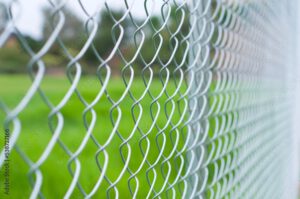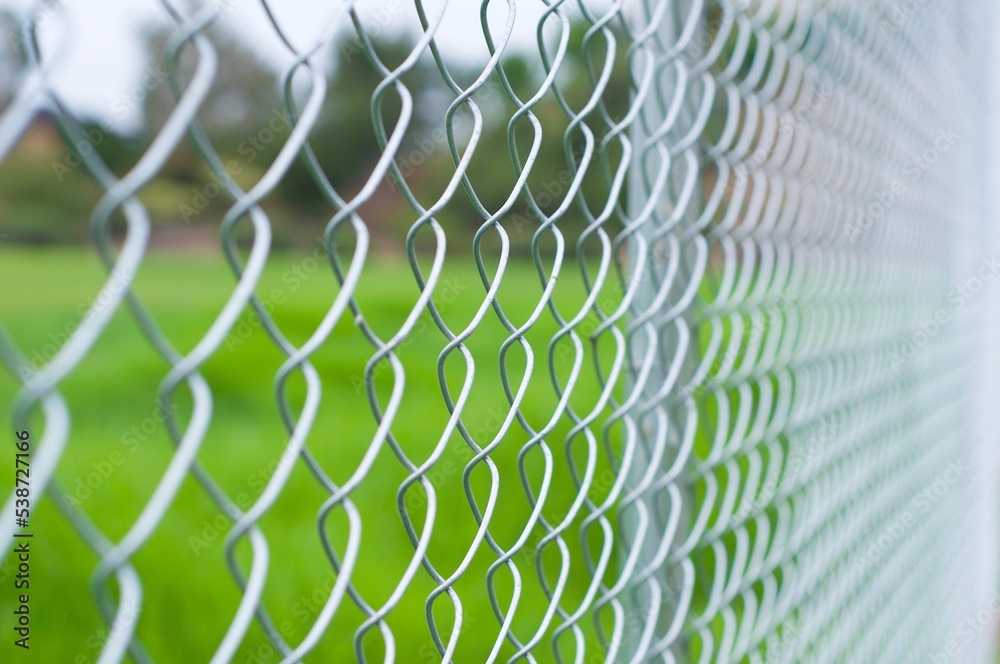While some people consider chain link fences unattractive, they can be customized to fit your needs. There are also many options to add to your bar. Adding metal slats and other extra features makes the fence more visually appealing. These fences give homeowners and businesses a sense of security and can keep trespassers off the property.

Chain Link Fence NJ is durable and strong, ideal for areas with a lot of use and traffic, such as children’s playgrounds or sports fields. They are made of individual strands of aluminum or steel wire woven together in a diamond pattern to create a material known as fabric. These wires are then connected to the chain link fence posts using steel or aluminum wire with hooks on one end called fence ties.
Chain link fencing comes in a variety of colors. While most people think of silver, chain link fences come in green, black, and chocolate brown. Manufacturers offer these colors as standard, but they can also custom-match them for special projects. However, this can add to the cost.
Most chain link fences are galvanized, which helps protect against the elements and rust. It is the most common style, but some manufacturers offer aluminized coating for added durability and resistance. This coating is used when chemicals or water spray may cause corrosion.
Other options to increase the durability of a chain link fence include adding three rows of barb or line wire for additional security. Depending on the application, this can be installed on the top or bottom of the wall and can be either vertical or cranked. This option adds to the overall weight of the fence, so it’s important to discuss this with your sales representative before making a decision.
Another way to increase the durability of chain link fencing is by installing an aluminized or galvanized steel fence post with a welded-on strainer. When tensioning the wires, the filter stops the base from being pulled toward the winders. It is an important addition to any fence over 1.8m, especially if installed in an area with cars.
In addition to increasing the durability of a chain link fence, it can be made more visually appealing by painting it or adding slats for privacy. Slats are inserted into the mesh for privacy and can be made of high-density polyethylene or aluminum. They can be installed vertically or cranked, easily removable, and replaceable if damaged.
Chain link fences are popular for many properties because they provide a strong security barrier, are relatively inexpensive, and are easy to maintain. However, some people feel that the aesthetic of this type of fencing needs to match the style of their homes. Fortunately, there are several ways to improve the aesthetics of chain link fences without compromising their functionality or durability.
The first step to improving the aesthetics of your chain link fence is to consider changing its color. While galvanized chain link fences are often silver, manufacturers now offer a variety of colors, including hunter green, black, and chocolate brown, which blend in better with the surrounding landscape and are more visually appealing than traditional metal fencing.
Once you’ve chosen a color, it’s important to choose rust-resistant paint to protect your fence and enhance its aesthetics. It’s also a good idea to apply the stain as soon as you finish installing your wall so that it has time to dry completely before exposure to the elements.
Another way to improve the aesthetics of a chain link fence is by planting vines, plants, or shrubs along its length. These can hide the chain link fabric, add privacy to your home, and provide a scenic backdrop for outdoor living spaces.
Finally, keeping your chain link fence clean and free of debris and buildup is important. Periodically inspect your wall for signs of wear and tear, and address any issues promptly to avoid further damage. In addition, you can make your fence look more polished by adding post caps to the wooden posts.
Many municipalities have regulations on the height and placement of chain link fences, so check with your local city or town hall for guidelines before beginning installation. Some areas may require that your bar meet setback requirements or be placed a certain distance from public rights-of-way. In some cases, you may also be required to obtain a permit for your fence installation. These restrictions can help prevent problems and ensure your new fence complies with the law.
Chain link fences offer several security benefits:
- They provide visual security. A waist-high wall tells any potential intruder that the property owner is taking proactive security measures.
- They can be enhanced with barbed wire to provide additional security.
- A chain link fence design provides a solid barrier that prevents scaling or climbing.
The silver or gray color of chain link fences comes from the metal’s coating, usually galvanized. This protective layer helps prevent rust and corrosion, which are the most common causes of damage to the fence. This layer is also what makes the wall easy to maintain. Unlike other fence materials, chain link does not require staining or repainting.
It is necessary to use tension bands throughout its length. These are installed at the fence’s corners, ends, and direction change points. Generally, the posts used to install these fittings are larger than those used for line posts to support this extra weight. Corner and gate posts are often concreted into the ground for added durability.
Some installers may add a row of barbed wire to the top or bottom of a standard chain link fence for increased security. It can be done by adding a “barb arm” to the end of the wall and running three strands of barb wire up the inside and outside. Alternatively, the entire fence can be wrapped in razor ribbon or concertina wire, a circular metal strand that forms coils. This type of wire is commonly used at prisons and maximum security facilities and makes climbing or scaling a chain link fence nearly impossible without sustaining severe bodily injury.
In addition to enhancing the overall safety of your property, these types of fences are also great for preventing unwanted pests and animals from entering your yard. While they don’t offer the privacy of wood or vinyl options, this can benefit homeowners who place a premium on their property’s curb appeal.
Even though chain link has an industrial or prison yard vibe, this type of fence can still look good with proper maintenance. The most important aspect is to ensure it’s kept clean and repaired as needed, preventing small issues from turning into bigger ones. Taking the time to do this will help significantly extend your fence’s life.
Among the easiest fixes for your chain link fence are straightening bent rails and replacing broken sections of the meshing. You can do these with a few tools, like pliers and wire ties. If you have a lot of rust, you can purchase metallic, anti-rust paint made expressly for fencing. Alternatively, straight vinegar can also be used to soften and remove rust.
Treating rust as soon as it appears is a good idea because it will eat away at your chain link fence and weaken it. Use a steel wool pad and some elbow grease to rub at the areas where rust is showing, then rinse it off when you’re done. A chemical rust remover that’s used according to the manufacturer’s instructions should also work for stubborn rust.
Before removing any portion of your fence, check your property line and talk with your neighbors to confirm that you’re both okay with it coming down on your land. You want to avoid ending up with a fence in someone else’s backyard!
If you need to remove a long section of your fence, cut it down to the nearest corner or end post. You can then roll the wall into a tight cylindrical roll and secure it with wire or ties at the top and bottom. It will prevent the fence from unrolling during disposal.
Another easy way to keep your fence looking nice is to plant fast-growing vines that naturally cover the fencing, hiding it with their lush green leaves. Morning glories are an ideal choice as they are fast-growing and come in various colors, from pinks to blues. Other fast-growing options include ivy, which can cover a fence if planted properly.

